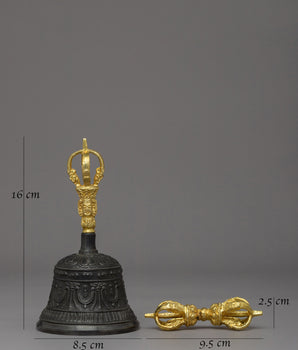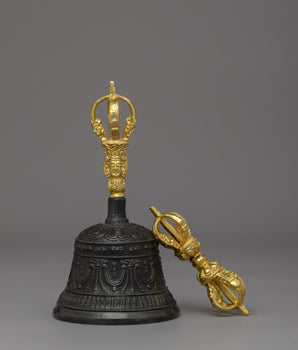Delving into the Profound Meanings of the 5 Dhyani Buddhas
The Vajrayana Buddhist philosophy introduces a captivating notion: the world consists of five cosmic elements, each represented by the Dhyani Buddhas. This perspective adds a fascinating layer to understanding existence and spirituality.
Their significance lies in their role as spiritual guides, aiding individuals in confronting the adversities encountered during their journey toward Enlightenment. Delving into a meditation on the Five Dhyani Buddhas and their symbolic meanings equips one with a powerful means to cultivate self-discipline, avoiding excessive self-gratification and unwarranted self-denial.
Named Vairochana, Amoghsiddhi, Ratnasambhava, Amitabha, and Akshobhya, the Five Dhyani Buddhas have acquired a spectrum of attributes over time, serving distinct purposes across diverse individuals and traditions.
The Five Dhyani Buddhas (Five Wisdom Tathagatas), also called the Pancha Buddhas, embody distinct qualities of Shakyamuni Buddha. They are recognized as the Five Conquerors or Victors in Sanskrit and hold a prominent place in Vajrayana Buddhist tradition.
While the concept of the five elements held a metaphysical essence, a yearning existed to translate it into art and architecture. Notably, at Somapura Mahavihara in Paharpur, this aspiration found expression in the central temple's design, embodying the essence of the Five Dhyani Buddhas. Four figures adorned the temple at the cardinal directions, with the fifth positioned at its heart. Each Dhyani Buddha, seated upon a lotus, featured a single visage and a pair of hands crowned with an emblem of their respective lineage.
Vairochana Buddha [The King]

Vairochana Buddha (Tib: Namnang) is the highest Buddha within the Pancha Buddha. As the Primordial Buddha, he embodies the wisdom of Sunyata and the essence of the Dharma realm meditation mudra.
Vairochana embodies the fundamental role of the Buddha as a teacher, a concept pivotal to the existence of Buddhism and the availability of the enlightenment path. Buddhism wouldn't have taken shape without this role, and the way to Enlightenment wouldn't be accessible. His dominion is believed to emanate from the world's core, encircled by the entirety of the Vajrayana pantheon, including the other four Dhyani Buddhas.
Depiction of Vairochana Buddha
Consequently, the supreme deity Vairochana radiates purity in his pristine white form, as white symbolizes the amalgamation of all colors. His lotus seat finds its foundation in the strength of two majestic lions, known as the sovereigns of the animal kingdom; their roar commands silence from all others.
Vairochana presents the Dharmachakra mudra, wherein Dharmachakra translates to the 'Wheel of Dharma' in Sanskrit. This mudra encapsulates a pivotal event in the Buddha's historical journey – his inaugural sermon to his followers in Deer Park at Sarnath after attaining Enlightenment. This gesture signifies the commencement of disseminating the Dharma teachings, setting the metaphorical Wheel of Dharma in motion.
Dhyani Buddha Akshobhya [The Mirror to Our Souls]

Akshobhya (Tib: Mikyopa) is revered for his capacity to transmute the human inclination towards anger into reflective and mirror-like wisdom. This wisdom enables us to perceive reality just as it stands, free from bias and emotional influence. Akshobhya, once a monk, made an unwavering commitment to never harbor anger or aversion towards any being. Through unyielding dedication, he evolved into a Buddha.
As a celestial Buddha, Akshobhya holds dominion over the Eastern realm known as Abhirati. Those who uphold his pledge find rebirth within Abhirati, where the assurance of not regressing into lower states of consciousness prevails.
Depictions of Akshobhya Buddha
In Buddhist iconography, Akshobhya is typically portrayed in shades of blue, occasionally adopting a golden hue. He is commonly depicted in the earth-touching mudra, a gesture reminiscent of the historical Buddha's action when he called upon the earth to witness his Enlightenment.
In his left hand, Akshobhya holds a vajra, a symbol representing shunyata – the absolute reality encompassing all entities and phenomena in an unmanifested form. Additionally, he is linked to the fifth skandha, which pertains to consciousness. Within Buddhist tantra, invoking Akshobhya during meditation transcends feelings of anger and animosity.
Ratnasambhava Buddha [The Gem of a Buddha]

Ratnasambhava (Tib: Gyalwa Rinjung), translating to 'Born from the Jewel' in Sanskrit, derives its essence from the term 'ratna,' symbolizing jewel. He is revered for his ability to transmute the adverse human trait of pride into the profound wisdom of sameness. This wisdom unveils the shared aspects of human existence, revealing the universal thread connecting all individuals, regardless of gender.
His realm of sovereignty lies in the South, and he is aligned with the second skandha, sensation. Engaging in meditation centered on Ratnasambhava Buddha effectively subdues pride and avarice, directing focus towards the principle of equality.
Depictions of Ratnasambhava Buddha
Ratnasambhava Buddha radiates a yellow hue in Buddhist iconography, which embodies the notions of earth and fertility. Often, he cradles a wish-fulfilling jewel, a symbol of abundance and fulfillment.
His hands adopt the wish-fulfilling mudra: his right-hand faces downward with the palm extended outward, while his left-hand forms the meditation mudra. This gesture embodies the spirit of generosity.
Ratnasambhava prominently presents the Varada mudra, a symbolic representation of charity and the bestowal of blessings. His emblematic attribute, a jewel (Ratna), solidifies his affiliation with prosperity. He is occasionally characterized as the Buddha of generosity, echoing his role as a giver.
Dhyani Buddha Amitabha [The Gentle and Lovable Buddha]

Amitabha Buddha, also known as Amita or Amida Buddha, holds an esteemed position among the Dhyani Buddhas. In ancient times, Amitabha relinquished his royal status to embrace monkhood. As Dharmakara Bodhisattva, he devotedly practiced for five eons, ultimately attaining Enlightenment and becoming a Buddha.
Amitabha Buddha resides in Sukhavati, recognized as the Western paradise or the Pure Land. Those reborn in this Pure Land relish the joy of absorbing Amitabha's teachings on dharma until they are prepared to embark on the journey to Nirvana.
His realm extends to the west, where the sun sets; he is envisioned as the descending red sun. Amitabha encapsulates nature's supreme force and vitality, manifested in our earthly realm, open and accessible to all. Little wonder that he stands as the most widely venerated of the Dhyani Buddhas.
Depictions of Amitabha Buddha
Amitabha epitomizes both compassion and wisdom, embodying qualities of mercy. He finds affinity with the third skandha, that of perception. In tantric practice, meditation centered around Amitabha is an antidote to desire. His visual representation sometimes situates him between the bodhisattvas Avalokiteshvara and Mahasthamaprapta.
Within Buddhist iconography, Amitabha's hands most frequently adopt a meditation mudra: his fingers lightly touch and rest folded over his lap, palms turned upward. His red hue symbolizes love and compassion, while the lotus, his emblem, embodies gentleness and purity.
Dhyani Buddha Amoghasiddhi [The Lord of Karma]

Amoghasiddhi is closely linked to the concept of energy and is acknowledged as the Lord of Karma. This Buddha embodies action, signifying the tangible realization of outcomes by harnessing the wisdom of the four other Buddhas. His double vajra also holds significance as a symbol of the sequential fulfillment of all endeavors. He governs the Prakuta Pure Land. Indeed, the entirety of Amoghasiddhi's presence dispels terror and fear.
Depiction of the Amoghasiddhi Buddha
Amoghasiddhi's body is depicted with green, a hue resonating with the serenity and stillness of nature. This tranquil and pacifying color possesses the ability to alleviate anxiety. He finds his mount in Garuda, a remarkable hybrid of man and eagle, known for consuming serpents. Endowed with a telescopic vision, Garuda detects the presence of negative delusions akin to serpents, even from a substantial distance. Furthermore, Garuda is affiliated with the northern Himalayan expanse, aligning with Amoghasiddhi's direction.
Meditating on the Dhyani Buddhas

Click here to buy our Dhyani Buddha Thangka
The Dhyani Buddhas, also known as the "Meditation Buddhas," are essential to Tantric and Vajrayana Buddhism. These heavenly beings give a route to Enlightenment through their unique attributes, personifying the highest truth and values of the Buddha. Followers can transcend their challenges on earth and reach a higher state of consciousness by adopting their teachings.
The Dhyani Buddhas give a transforming journey through meditation. We align with their characteristics by submerging ourselves in their qualities and awakening our dormant potential. The cultivation of a profound change in consciousness that results in inner tranquility and self-realization is fostered by seeing their brilliant forms and embracing their wisdom.
The five Dhyani Buddhas act as mirrors, reflecting both our inherent strengths and flaws. We set out on a path of profound transformation by comprehending their symbolism and adopting their qualities. We can overcome the restrictions of the ego and accept the limitless wisdom they offer via dedication, meditation, and thoughtful living.
The five Dhyani Buddhas' realm unfolds as a transformation journey. These deities, rooted in the Mahayana tradition, represent the pinnacle of transcendence, wisdom, and compassion. We set out on a mission to understand the transformative potential of these enlightened beings as we delve into their symbolism and importance. We can navigate the intricacies of life with the knowledge and compassion they exemplify, transcending ignorance and embracing a higher state of consciousness.















